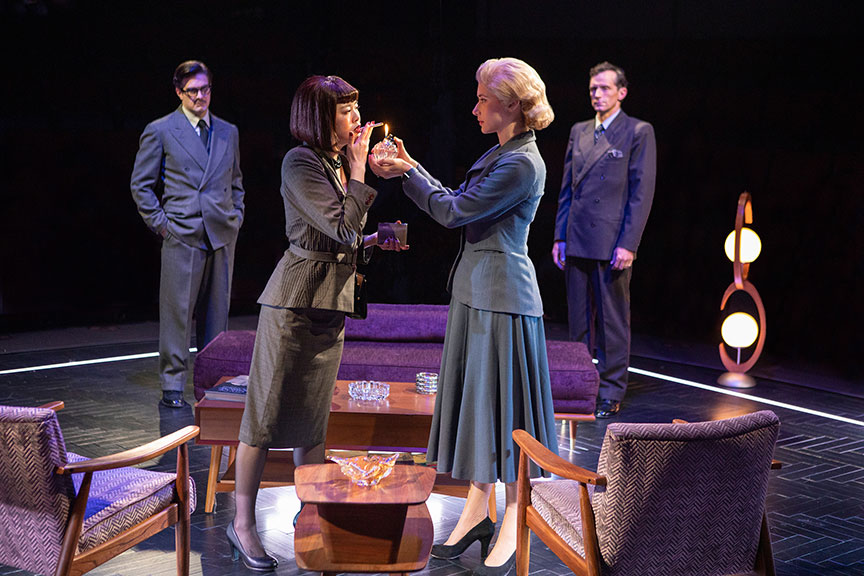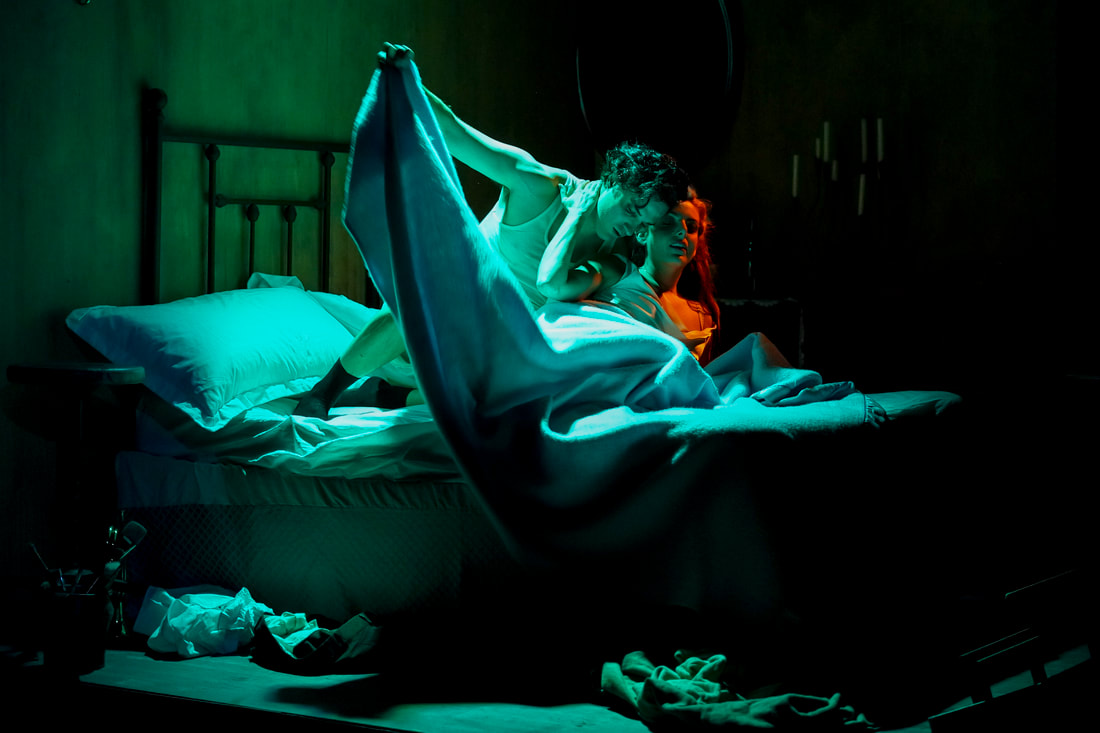|
In forefront: Ruibo Qian (left) and Kate Abbruzzese in "Dial M for Murder." Photo by Jim Cox atta If a mystery is well written, every line moves the story forward.
Frederick Knott’s play “Dial M for Murder” is a well-written mystery. Created for BBC Television in 1952 it moved quickly to a London’s West End stage and then to Broadway. Most famously, it was turned into a film two years later directed by Alfred Hitchcock and starring Ray Milland and Grace Kelly. Place it in the hands of veteran playwright and screenwriter Jeffrey Hatcher and you have a “Dial M” for the 21st century. His commissioned adaptation for the Old Globe Theatre possesses all the twists and turns of Knott’s original play and the stylishness of Hitchcock’s film, but even though the story remains set in the 1950s, there’s one contemporary invention: The lover of London socialite Margot Wendice (Kate Abbruzzese) with whom she’s deceiving self-centered husband Tony (Nathan Darrow) is a woman (Ruibo Qian). (In case you’re wondering, man-about-town actor Bob Cummings portrayed Margot’s lover in the movie.) Other than making Tony a failed writer rather than a retired tennis player – a device that enriches the tale’s irony – Hatcher stays quite true to Knott, a playwright he admires. “Dial M’s” is a simple premise: Tony decides to murder his wife for her money in a plot that involves both blackmailing her and the man Lesgate (Ruy Iskandar) that he hires to do the deed. How Tony’s plan goes down is far from simple. A stage mystery like this one requires active listening. It’s a talky affair by necessity, especially through most of the first act, and should your mind wander you’re likely to miss an important clue. “Dial M for Murder” is what Hatcher calls an “inverted mystery,” one in which we know who the killer is from the beginning, so it’s not a whodunit. The attraction for the audience is, like in a cracking good episode of “Columbo,” witnessing the villain setting up his crime then later covering his tracks. The five-person cast onstage in the intimate Sheryl and Harvey White Theatre performs with panache while avoiding what had to be a temptation to overplay their hands in a true genre piece like this. Darrow is all smug energy and calculation as the morally vacant Tony. Abbruzzese could be one of Hitch’s cool blondes, but she gives her Margot some fire and resolve beneath the rich veneer. As Maxine Hadley, Margot’s mystery-writing paramour, Qian is the smartest person in the room, including the investigating Inspector Hubbard (John Tufts) and especially including Tony. Under the splendid direction of Stafford Arima, the actors are frequently in motion, making the most of the small space and emphasizing where they are and where things are (as in potential clues) in the evolving mystery. It’s best to keep your eyes as well as your ears open throughout the two-hour drama. Lighting design by Amanda Zieve, sound design by Leon Rothenberg and snippets of sultry music heighten the ambiance and the suspense. Ryan Park’s costumes, particularly for Margot, would please Hitchcock. Fight director Rachel Flesher deserves plaudits too for the disturbingly believable attack on Margot by Lesgate. To say more about it would constitute a spoiler. There’s a lot of exposition and explaining in the script, both before and after this confrontation. Mystery lovers will be indulgent. Others? Well, there’s always those gorgeous costumes, witty byplay and a phone that startles the hell out of you when it rings. “Dial M for Murder” runs through Aug. 28 in the Old Globe’s Sheryl and Harvey White Theatre in Balboa Park.
0 Comments
Adam Pascal and Olivia Valli in "Pretty Woman: The Musical." Photo by Matthew Murphy The stamp of rocker Bryan Adams is all over “Pretty Woman: The Musical,” for which he wrote the music and lyrics alongside fellow Canadian Jim Vallance. Its score is populated by booming, anthemic songs reminiscent of 1983’s “Heaven,” which Adams composed with Vallance.
In the musical adaptation of “Pretty Woman,” now playing at the Civic Theatre downtown in a Broadway San Diego presentation, the majority of these reverberating ballads are rendered by Adam Pascal, playing the role of Edward that was originated by Richard Gere in the hit 1990 film with Julia Roberts. Pascal might as well be Adams in a gray suit, especially when he’s soloing on the likes of the musical’s “Something About Her” and “Freedom.” This is a LOUD show – no two ways about it. Louder than it should be. Its 16-song score could have benefited from the lighter, buoyant touch of Roy Orbison’s classic “Pretty Woman” tune. (That does turn up in this production, but not when you expect it to.) Not only does Pascal sing to the rafters, but during “You and I,” in which Edward takes prostitute Vivian (Olivia Valli) to the opera, Amma Osei belts out an aria that could awaken the ghosts in nearby Horton Plaza. The most entertaining and least histrionic of the show’s musical numbers are those featuring Kyle Taylor Parker, who plays multiple roles under the character description “Happy Man.” Two of them come back to back in Act One: “On a Night Like This” and “Don’t Forget to Dance.” Whether he’s the hotel manager who teaches Vivian how to tango or the unofficial emcee presiding at the opening of each act, Parker is delightful. Most impressive, he’s able to overcome the cliché that is the exhorting “Never Give Up on a Dream” in Act Two. By now you’re wondering: “What about the Vivian character, the role that turned Julia Roberts into a star? How does Olivia Valli fare in Roberts’ knee-high boots?” Just fine, it turns out. Valli is deft with her comic moments and actually more believable as a woman of the evening than Roberts was. There’s a disconnect, however, when she’s given a song to sing, and naturally there are many of them in “Pretty Woman: The Musical.” The Vivian singing sounds like a completely different person than the Vivian speaking. That’s no knock on Valli, who has an excellent voice. It’s a consequence of turning “Pretty Woman” into a musical. Vivian’s best numbers are those with fellow hooker Kit (Jessica Crouch), whose own street wisdom is off the charts. The show’s book by Garry Marshall (who directed the movie) and J.F. Lawton (who wrote it) rarely deviates from the big-screen romantic comedy. Many of the exact lines are resurrected. Thirty two years later, it’s still a problematic setup – a prostitute’s Cinderella dream coming true – and just as illogical practically from start to finish. The appeal then as now is in the recognizable costumes, the Beverly Hills backdrop and Vivian’s fish-out-of-water exposure to the rich and entitled. “Pretty Woman: The Musical” lasted only a year on Broadway, but if the cheering reception it got on the night I was there is any indication, it may be in for a healthy second life as a touring show. A lot of folks, it would seem, want the fairy tale. “Pretty Woman the Musical” runs through Sunday at the Civic Theatre, downtown. Jose Balistrieri and Claire Kaplan in "Blue Period." Photo by Daren Scott It’s not unusual for artists of any medium to produce with prolificacy during a dark time in their lives. Such was the case with Pablo Picasso, whose melancholy work between 1901 to 1904 is considered his Blue Period. Anyone with even basic knowledge of Picasso has heard of the Blue Period and is familiar with its most emblematic painting, “The Old Guitarist” from 1903. What they may not know was what plunged Picasso into this somber stage of his career.
The truth: an abiding but obsessive friendship, and more so the deterioration and loss of that friend. As dramatized in OnStage Playhouse’s world-premiere play "Blue Period," by Charles Borkhuis, a young Picasso’s best friend in Paris, Carles Casamegas, consumed his energies practically as much as his paintings. While the 19-year-old Picasso (Javier Guerrero) worked to establish himself in an art society where Matisse and Renoir reigned, his devoted yet troubled companion, Casamegas (Jose Balistrieri), teetered back and forth on the edge of self-destruction. An in-his-mind failed artist himself, Casamegas also suffered from twin addictions: one to morphine, the other to Picasso’s ravishing model, Germaine (Claire Kaplan). As the play directed by James Darvas opens, Casamegas is in high spirits in every sense of the word, prancing about in a mask (no symbolism there, right?) while his friend works on a portrait of a scarcely clothed Germaine. It is the most ebullient we will see Casamegas over the ensuing two hours as very soon it becomes apparent that he has little control over his demons or his emotions. If it were 2022 instead of 1900 he’d be classified as dangerously manic-depressive. Because the character’s wild instability is so theatrical, Balistrieri overshadows Guerrero’s by-comparison-restrained Picasso, not to mention Kaplan or Herbert Siguenza as leering art dealer Pere Manyac, in Act One of “Blue Period.” Act Two is a very different proposition, with the focus turned to Picasso, his depression and guilt, and how they compel him into tortured years of driven work that will ultimately alienate both Germaine, who loves him, and Manyac, who’s been acting as his agent. What you have is almost two separate plays on stage – one playful then histrionic, the other as muted as the paintings of Picasso’s Blue Period. It’s not an easy narrative transition. The performances at OnStage help, though Guerrero never fully affects the degree of charisma that is associated with Picasso. Balistrieri owns the showcase part. His Casamegas is brokedown, nearly out of control. The multitalented Siguenza, whose one-man show “A Weekend with Pablo Picasso” is as departed from “Blue Period” as could be, is underutilized in a relatively straight role. He is due some credit, however, for bringing this promising play to the attention of Darvis, who is OnStage’s artistic director. Kaplan is magical as the model Germaine, in her way in love with Picasso, Casamegas and her husband in an open marriage. She is so beautiful and brimming with life that the resulting contrast with the brooding Picasso of Act Two is all the more dramatic. Here and there “Blue Period” could stand a bit of trimming, but it’s a frequently inspiring mingling of art history and psychology. All that and Paris too. “Blue Period” runs through Aug. 7 at OnStage Playhouse in Chula Vista. |
AuthorDavid L. Coddon is a Southern California theater critic. Archives
July 2024
Categories |
David Coddon |
|


